Editor's note: This post is part of a series of unpublished interviews from the personal research archive of noted guitar writer Tony Bacon. These interviews will be appearing on Reverb in the coming months.
Stay tuned for more interviews from Bacon's Archive coming soon. For previous installments, take a look at Tony's interviews with Tom Petty and Chet Atkins, as well as conversations with Leo Fender's longtime partner George Fullerton and Gibson's Ted McCarty.
During the ‘80s, Fender’s poor reputation and dipping market share led the CBS management to hire several top guys from the American arm of Yamaha to try to resolve the problems. The job of overhauling Fender’s electric guitar lines fell to Dan Smith.
Dan was right in the thick of things when Fender began to make guitars in Japan and when CBS, which had owned the company since 1965, sold Fender to a group of employees that included Dan.
For my various books about Fender and Squier, I interviewed him many times, from the mid-‘80s through to his retirement from Fender in 2006 and before his death in 2016. What follows is a conversation we had in February 1992 at Fender’s then-new factory in Corona, California, when we looked back at Fender’s eventful ‘80s.
When did you start at Fender, Dan?
I started with Fender in August of 1981. I’d been at Yamaha since January 1977, and I was part of the development team there—I came in as they had just finished developing the SG series, and I worked on the SA series and the BB basses. My last two years at Yamaha, I was not only the marketing guy for the electric guitars, but I picked up the amplifiers as well. Before Yamaha, I’d had my own repair shop back in Rochester, New York, for five years.
I came on board at Fender in ’81 with a number of people from Yamaha, and I was brought in to head up the electric guitar department. John McLaren was hired by CBS to head up CBS Musical Instruments, the whole division, which included Steinway, Gemeinhardt, Lyon & Healy harps, Gulbransen, and so on. Fender was kind of the only moneymaker for a long time. Steinway always did all right, but some parts of the division weren’t doing that well. At that time we all kind of thought we’d been brought over to resurrect the division.
Was that your brief, to do a little resurrection?

We were brought in to turn the reputation of the company around and to get it so it was making money again. It was starting to lose money. During one point in the ‘70s, my understanding is that CBS was taking out about a million dollars a month in profit. There was not a lot of money going back into the company. One of the problems was that they really did not have a lot of music people at the helm during that time and—this is just my supposition—a lot of the guys at CBS just used to be president of Fender as a stepping stone for getting further up the hierarchy.
The company had no soul at the top. When I first came there, I sat down and talked to guys like John Page and Troy Lane and some of the guys working on the line, and the players who worked for the company were real unhappy. They’d come to work for Fender because it had been a dream of theirs as kids to work for a guitar company, and they came in and they cared about the quality of the product. But the management at that time could really give a shit.
Can you give me an example?
They were making about 300 guitars a day, and they had three inspectors for the whole thing. A guy got a raise for the more guitars he could inspect in a day. Each guy that was building guitars had to do at least 50 to get paid. They had about six builders, and if they got up to 75 they got to another level in the union. If a guy could do 150 guitars a day, that was really it—it was quantity.
When we first got there, in ’81, the guy that was head of quality control made a statement that there was 97 percent "good"—I can’t remember the exact term he used, but he said they had no problems with 97 percent of the product. We knew, coming from Yamaha, that when you work for one company—when you’re going out testing product, talking to dealers about what you should do—you don’t always find out the truth about your own company, but you sure as hell hear about how people feel about everybody else. And at that point in time everybody hated what Fender had become. For about 10 years, the quality of the product had been awful. Not that there weren’t good guitars made during that time, but generally it had really gone down.
Why do you think that was?
I think a lot of it had to do with the fact that you’d got a facility staffed with x amount of people, and that factory could probably produce y amount of good guitars. But they wanted more guitars. The factory could still only produce y amount of good guitars.
Anyway, we went out and pulled guitars out of the warehouse and re-inspected them, 800-and-something guitars, and out of those I think only about 15 passed the existing criteria. This after the chief of quality control had said everything was all right. So John Page and Troy Lane and I, we sat down and re-wrote the criteria. Because in some ways it was too strict. They were taking unbelievable pieces of ash and painting them black because someone had decided natural should only be perfectly straight lines with no figure at all. So I went out in the paint room, and we’re painting stuff that Schecter and all those guys at that time were getting $300 or $400 a body for—and we were painting them black! But there weren’t too many things that were too strict.
What was the Fullerton factory like when you first took a look?
Everything was antiquated. We had come from Yamaha—and at that point Yamaha probably had the most modern guitar factory in the world, for both acoustics and electrics—into a factory where guys were hand-cutting on a bandsaw with no guards, cutting out the contours. They’d have a thing they’d lay on top of it as a guide, they’d put a pencil mark on the back and a pencil mark on the front, they’d lay it into a tray, and the bandsaw blade was exposed so much. If that blade had snapped or something like that, the guy’d be dead.
Every hole that was drilled in the body was done on a different drilling machine. Guy’d stop, drill two holes here, go over here, do another one or two—none of these things were connected. There was very little automation at all. When we got there, there were 90-something people on the neck line, who could only make about 120 necks a shift, of which we would probably reject at that time maybe 30 or 40 necks.
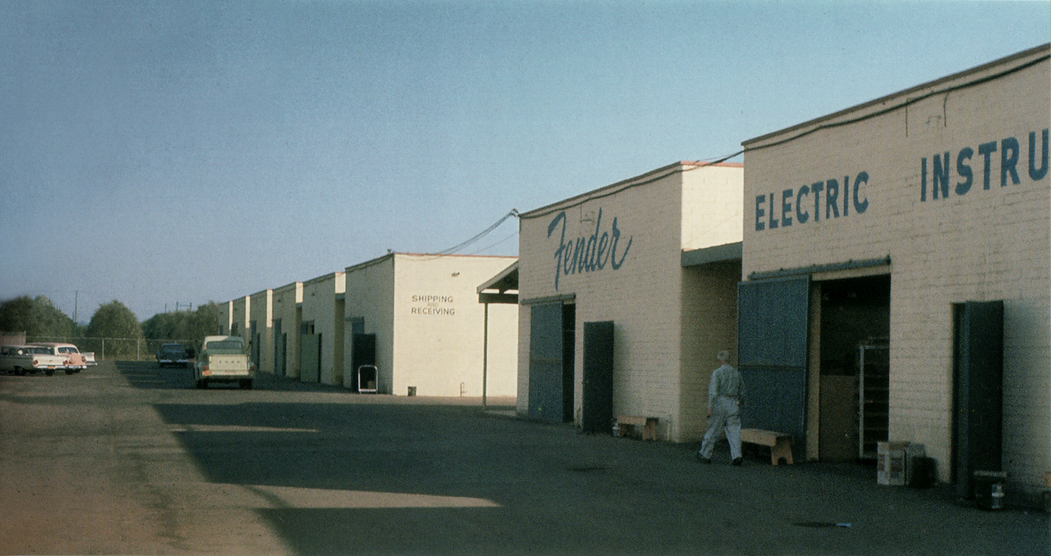
And nobody had been saying, well, hold on, this is all wrong?
A lot of the line supervisors had come up from working in the warehouse. They didn’t know anything about manufacturing at all, but they’d moved up the ladder because the union said they had to, and all the rest of these things that took place. We had a lot of people there, and it wasn’t that they didn’t want to do a good job, it was that no one was directing them as to how to do a good job.
I came in and I walked through the plant, and I met some people, and we thought we knew how bad it was. We took it for granted that they could make Stratocasters, Telecasters—the way they used to make them. But we were wrong. So many things had been changed in the plant over 10 or 15 or 20 years. We’d brought in some good ideas, put this task force together, worked on it for about four years. It took us about four years, right before CBS decided to sell the company—we’d finally got everything working well. Because what would happen, every time we got something fixed, there’d be something behind that which needed fixing.
It would have been easier if the place had burned to the ground and we’d bought new equipment and brought in new people and started all over again."
It would have been easier if the place had burned to the ground and we’d bought new equipment and brought in new people and started all over again. That’s what we did when we moved to this new factory here in Corona in ’85. We started from scratch, and that took us about a year-and-a-half to two years, versus four years to try to correct the problem at Fullerton.
One of the things we were up against: We had people who’d been doing the same thing for 20 years. They saw hundreds of guitars go out, so who were we to come along and say they were doing it wrong? There was a lot of animosity, and it kind of divided into two camps. There were the people who really cared about guitars, like a lot of people on the line who played and got on our side and felt we were doing the right thing. And there was this other group of people that really felt that they knew what was best. Actually, the company had been driven by manufacturing for probably 10 or 15 years and not by the market.
The first time I met with Forrest White, he showed me a film, and also a bunch of pictures. Forrest was an industrial engineer who had come from Westinghouse or somewhere—he came along to Leo in the early days and helped him set up the factory. So Forrest showed me pictures of the factory, and that was exactly the way we ended up with it, when we did it. So in between when Leo had it and CBS had it, somebody had really fucked it up. And badly.
Did the fact that you’d been with the American arm of a Japanese company affect the kinds of changes you made? Their systems seem to get people working together.
Bill Schultz [the new president of Fender/Rodgers/Rhodes] had been with Yamaha for 14 years before he came to CBS. I was there five years, and for me it was probably like going to a real good college for five years. You learn a lot. But I don’t think any of us were schooled in how a factory should be run. I think what CBS did and what a lot of the conglomerates did, they brought MBAs in from outside the industry itself who said, "OK, if you’re gonna make widgets, this is how you make widgets." Everybody has a department, so many little kingdoms. I think what we did was a combination of what we’d done at Yamaha, where things were done with people getting together, but also just the fact that when you walk in and look at something, doesn’t it kind of make sense to get people working together?
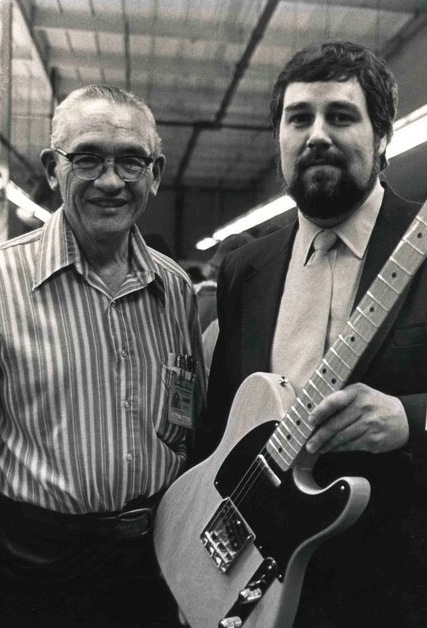
Bill’s mandate, when he virtually stopped production at Fullerton, was that quality came first. Freddie Tavares had been with the company since 1952, ’53 maybe—he’d sit with me and talk, he’d tell people when they got disgruntled, he’d say we had problems on the lines, problems with supervisors, probably gave people more of an opportunity than we should have, and after about two-and-a-half years a lot of those people were gone. But Freddie would go out and sit with those people and say, "Look, you don’t have to blow product out, nobody’s telling you you’ve got to make the quantity." We shut the line down twice, all the way down to where we were making three guitars a day, because that’s all the good pieces we could get through the line. But some of these people wouldn’t buy the program, they couldn’t change their thinking.
It took us an incredibly long time to get things the way we wanted, a lot longer than we thought. And it probably worked to our benefit. I believe that CBS had planned on selling the company all along—and that’s just my supposition, I don’t have any proof for that, but I think that was probably in the works. So they were hoping that we would straighten it out and get it to the point where it was sellable. I like to tell people we had four-and-a-half years where we delivered loaves and fishes, and they wanted us to walk on water. We just didn’t do the right miracle.
I believe one of your early projects was to revise the regular Stratocaster that CBS had been making.
With John Page’s help, one of the first things that I knew, coming from the outside as a player—and half the guys on the inside knew this, too—was nobody wanted to buy a three-bolt neck with a great big headstock and a bullet truss-rod. So one of the first things we did was to change the product back over to four-bolts. We had an incredible amount of inventory of bodies and parts that we had to work through, but we changed it back to the four-bolt neck and the right headstock.
Also, we knew that the best thing for Fender to bring out to show people that we were back was to reissue what everybody loved, which is why we did the ‘57s and ‘62s and all that kind of stuff. So we looked at a lot of vintage guitars. I’ll never forget John and I going to DeKalb, Illinois, where we’d found that Larry Henrikson at Ax In Hand had about 200 Fenders in place. So we went there, landed in Chicago in January, freezing cold, about 70 below. Can’t remember how many hire cars we went through before we found one that worked. Finally we get to Larry’s shop and spent a whole day there.
We were there on the mission to make sure we measured the stuff and got the data. We wanted to get it as close as we could. We took pickguards off, took pictures of pockets, tested paint, measured necks, all that kind of crap. And we left having bought perfect examples of each era, too. I remember we spent $5,600 on three guitars, which for Fender at the time was ludicrous. We went out and bought back our own product!
We bought a ’57 P-Bass, which we still have—it was pristine when we got it. We bought a ’60 Jazz Bass, we bought a ’61 Stratocaster—the body was ’60 and the neck was ’61—and the sad thing about those, I mean we bought them because we wanted to take them apart, so they look like shit now. We actually had a ’51 Tele, and the sad thing is it might have been one of the first ones that said Telecaster, a very early date. We had that guitar, and an early ‘50s P-Bass. But there was a fire in the then-R&D building and we lost, oh, the Tele, a ’56 Strat—we’ve still got bits of the burned-up Tele hanging on the wall.
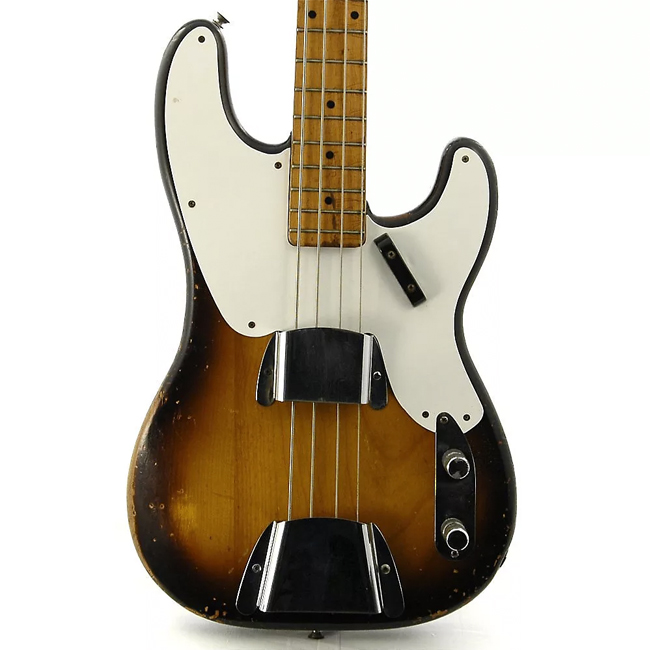
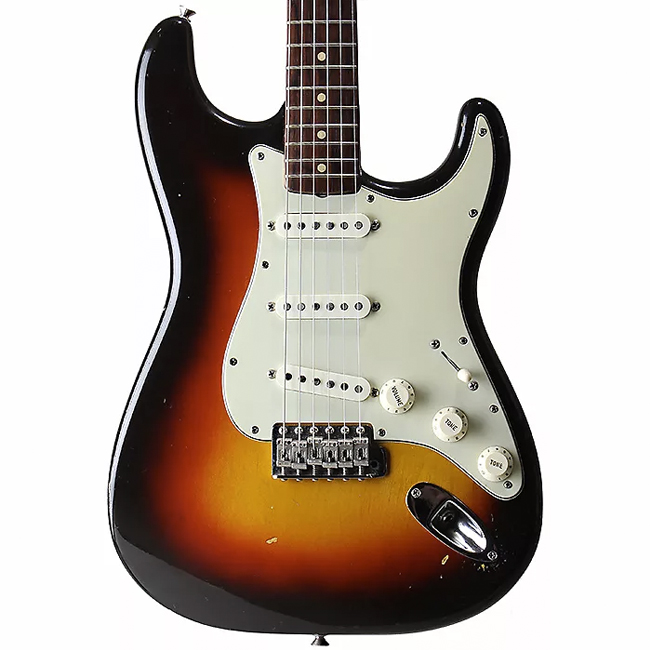
Anyway, that trip to Larry at Ax In Hand helped us launch the Vintage series. And so when people said oh, the contour isn’t right, this isn’t right, that isn’t right, you know what? We did not see two guitars that had—in fact, he had successive serial-number Stratocasters, and one of ‘em had real skinny contours, the other one was almost like something from the ‘70s. There was nothing bullshit about them either—they were right.
I used to work in a music store in the late ‘50s all the way up to ’64, from eighth grade on through high school. First of all, I used to help clean stuff up, and then I was a teacher. I used to unpack Fender guitars. We used to send stuff back. Some of ‘em were great guitars and some of ‘em weren’t. The ones that everyone thinks so finely of are the ones that survived because they were good instruments.
So, anyway, the first thing we did was to go back to the four-bolt neck for the Strat [since nicknamed the Smith Strat], then we introduced the Vintage reissue series, in January of ’82. The actual first vintage piece, the Telecaster, was in June of ’81, before I got there, which was nowhere near what an original Tele was. We’d gone back to the original body style, but they were using the ‘70s Tele body style, and they had polyester on it. In ’82 we relaunched the whole line. We had a big launch lunch—Steve Cropper came, and Dick Dale, Dave Mason, a big Telecaster cake. That’s kind of what got us started again.
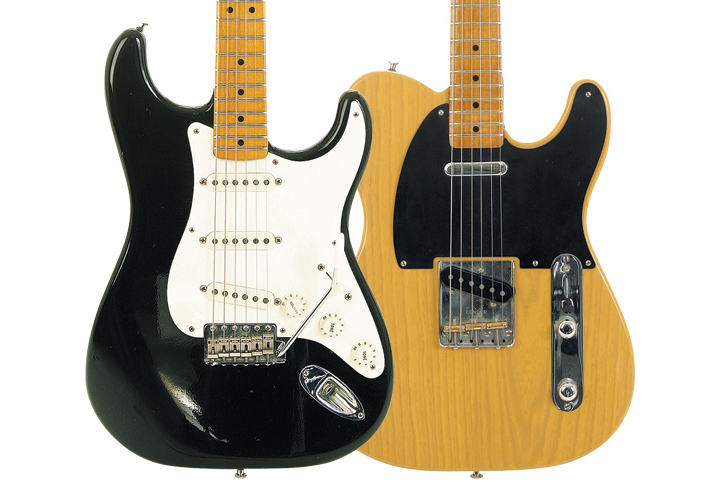
Was the Fullerton factory working well by that time?
The problem we had was that we kind of took for granted that the factory probably could make those. As it turned out, we just didn’t know how difficult it was. I know now that even releasing product through a factory that runs great, it probably takes about six months from the time we turn it over to the point where it’s gonna go. We had been used to the Japanese who had these huge R&D staffs, like 120 people. We’d talk about something, and five weeks later the first prototypes would come over, then the first production, and before you knew it we were up and going. So that was us being a little naive.
But the other problem was that we had incredible problems in the factory. I don’t really think that the factory was running the way we needed it to until probably the first of ’84. It took us probably three years to get it to where it was running real smooth. We had basically retrained everybody, we had classes twice a week for about a year and a half.
Did your experience with a Japanese company, again, have anything to do with the decision at Fender to manufacture in Japan?
One thing that we knew from working with Yamaha and from going to Japan a lot was that the Japanese companies made their money in their home market, and they sold everywhere else in the world at very little margin. So we knew that. And not only did we have to get the image of Fender back up again, and get the quality standard built up to make that happen, but we had to stop this plethora of copies. A lot of arrogant companies, like Tokai, a lot of these companies basically told Bill Schultz and I that they were gonna bury us, that they were gonna be Fender, that whether we liked it or not they were gonna take over the marketplace.
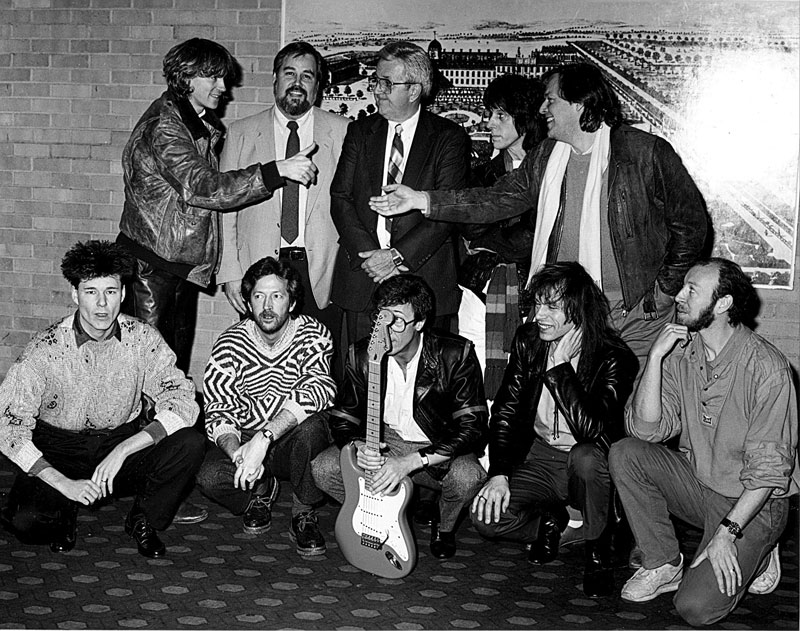
David Gilmour, Stuart Adamson, Eric Clapton, Hank Marvin,
Steve Howe, and Richard Thompson
I’ll never forget the interviews that George Gruhn did for Guitar Player magazine with all the American manufacturers, and he interviewed these guys from Fender who said basically that nobody would ever buy a guitar made in Japan or Korea, so why should they worry about these copy models? Now, there I was sitting at Yamaha laughing my ass off. Little did I know that I would be coming to Fender and suffering because of their idiocy!
And I mean, just like maybe England was guilty of 50 years ago, I think that one of the problems we’re going through now [speaking in 1992] in the U.S. is because we don’t want to admit the truth. We still think we’re the greatest. Well, everybody at Fender thought that—that was the attitude all through the company.
When I first started there, you go talk to someone in the factory to tell them they had to make a better product, they’d go, "Fuck it, we’re Fender, if the dealer doesn’t like it, we’ll just sell it to someone else." They said they never got any dealer returns. The reason they never got any dealer returns is that they wouldn’t let them send anything back [laughs].
Who came up with the idea of making Fenders in Japan?
The original decision was a combination of Bill Schultz and Roger Balmer [Fender’s then head of marketing and sales]. They were talking about that before I got there. When I got there, one of the first things I said to them was, "Look, you’ve got to go to Japan." We all had the same idea because we all came from the same area. But it was funny, when we got to Fender it was like everybody in Fender, except for a few people, lived inside this ivory tower. They had no idea what went on outside. No concept of what was going on out in the real world. So we’d tell this to people and they’d look at us as if we were nuts.
Roger and Bill had gone to Japan first to set up Fender Japan, and that would be the umbrella for all this to work. And with CBS’s blessing, they started it with Mr. Kojima from Kanda Shokai, they got Mike Yamano involved from Yamano Music, and us. [Yamano had been the Japanese distributor of Fender for some time. Kanda had been made an additional distributor more recently.] They put the money up, we put the licensing up, and that’s how Fender Japan got started.
Their asset was the production and your asset was the name?

Their original asset was the funding to set up Fender Japan. They suggested the Fujigen Gakki factory, which was the company that had been making with Ibanez. We were very familiar with them and felt that they were the best factory. Originally, they talked to Tokai, they talked to Kawai, who were making guitars for Fernandes, but really Fujigen had the best factory. So we went up there, and I came back with them in March ’82, and they’d gone with our plan, which we had drafted in the fall of ’81. To be honest, Kanda Shokai had been selling Greco copies of Fender—everybody in Japan was selling copies of Fender. Fuji had been making those Greco copies, so they were pretty well prepared to make Fender guitars.
We went up to their factory and we talked, and at that point in time their factory was pretty antiquated, except you could eat off the floor. It looked like what Fender was trying to do, which was old, but everything, the tooling, everything was really nice and neat and clean, and they really did a nice job. I went up there and spent two weeks with them, I hand-carved necks for the shapes that we wanted, all that kind of crap, and we sat and talked about which models we wanted for the market, what colors, and basically put the line together for the Japanese market.
But a secondary line for Europe initially came in that had "Fender" and then a small "Squier series," and then the distributors got upset and said no, that’s going to interfere with the stuff we’re trying to sell from the U.S., so we changed it to just "Squier," and then "Squier By Fender." Then six months later, all the distributors wanted us to change back again, but we said we couldn’t do it. I think the first product started to come into Europe about mid-’82, basically vintage-style product from offshore, very well made stuff, really nice pieces.
Why did you hold off introducing those to the U.S. market?
Because we were trying to solve the problems in the factory. We thought that would be the kiss of death if we started bringing in product that was already better than what we could make. In fact I’ll never forget when the first samples came in and everybody came up to inspect it, and these guys almost cried, because the product was what we were trying to do and having a hell of a time trying to do.
So the main purpose of starting this was so that we could have a product line, sold in Japan, to compete with the Japanese companies that were ripping us off. We’re selling somewhere between 30-, 40-, 45,000 guitars a year in Japan through Fender Japan [speaking in 1992] that has basically cut the copy guys off at the knees.
Japan is like a double-edged sword. We can experiment with stuff over there. It’s their factory, we don’t own it, so if we put an order in and we agree to buy it, and then decide we’re not going to buy it any longer, as long as we finish off with the production that we’ve obligated ourselves for, we can step away from it. Here, we invest a lot of time and effort to make that happen, so almost every product we stick in the air, we almost have to know it’s going to be a success. That’s just the way it is.
For us, number one, the Japanese connection has probably helped us to get back on our feet, after we bought the company. Number two, even before we bought the company, it stamped out some of the people who were trying to copy us. And thirdly, it actually helped bring some money in while we were trying to rebuild the plant. And another thing: we’re selling more guitars worldwide now than Fender ever did in a year. We’ve got more units in the Japanese market than we ever would have got if we just started shipping stuff from here.
And the Fujigen connection has allowed us to sell a lot more guitars than we could’ve if we just had this factory. We can only make so many here in Corona, 60- to 70,000 a year, and we’ve got paint requirements and stuff with the state. Fender in its best year, historically, sold 75,000 guitars. We sell three to four times that many at this point [speaking in 1992]. But to do that we have guitars made in Mexico, Japan, here, and, although it’s diminishing, we still have guitars made in Korea. The main reason is to balance off the production. The other side of it, too, is just from a marketing standpoint, because there are people out there who would like to get a vintage-looking guitar and don’t have the bucks.
I think it was around summer ’84 that CBS decided to sell Fender.
Yeah, June or July. Bill Schultz went to CBS to give them a proposal—which really in essence is what we’ve done. He said look, we’ve got the quality up, we’ve got the factory working real well, and we think we ought to change the following things—the union problems, we felt the building we were in was just too big, the Rogers drum thing was pretty much dead, and Rhodes pianos were still good instruments and everything, but that was a product that was so well made that once you bought one you never needed another one. So Bill went to CBS with this proposal, that to get your costs down and get it real profitable we need to do this, this, and this. And when he went to that meeting he was informed that the company was being put up for sale.
To be honest, if nobody had come up with an offer better than liquidation, Fender would have gone under. That would have been it. Over. Done."
Initially they didn’t offer it to us. They didn’t even want to entertain an offer. We have a paper here called The Recycler, which everybody sells their used goods in, and they almost did that kind of a deal, advertising it on the open market. So we got calls from every Tom, Dick, and Harry. Mostly it was our competition wanting to come through and have a look at the books [laughs]. Every couple of days somebody’d be flying in and we’d have to tell them what we were going to be doing.
Then mid to late November, CBS finally said look, we’re not going to have any success selling this for what we want to sell it for. We’re getting all these low-ball offers. We’d like to offer it you guys. If you can raise the capital, we’ll sell you the company, as long as your offer is better than liquidation. To be honest, if nobody had come up with an offer better than liquidation, Fender would have gone under. That would have been it. Over. Done.
Until the day before we went to the trade show in January of ’85, that morning, we hadn’t heard from CBS whether the offer was going to work out. Bill Schultz and Bill Mendello [chief financial officer of the instruments division] called them up, said look, we’re not gonna go to the trade show and show the product unless you tell us that the deal’s good, we’re gonna walk. Which was a pretty ballsy thing to say. They came back on the phone about 20 minutes before the trade show opened in order to let us know they’d sell us the company.
Bill Schultz and Bill Mendello went out from November through March to put the deals through, went to all kinds of banks. And because the company had not been profitable for the last four or five years, nobody really was jumping to loan us any money. Plus, there was a lot of leveraged buyouts taking place in the early ‘80s, a lot of takeovers, and a lot of money was starting to turn sour. It was becoming unpopular at the time and a lot of the venture capitalists were not really big on loaning the money. And so they eventually went and found a local bank here, who lent us the money.
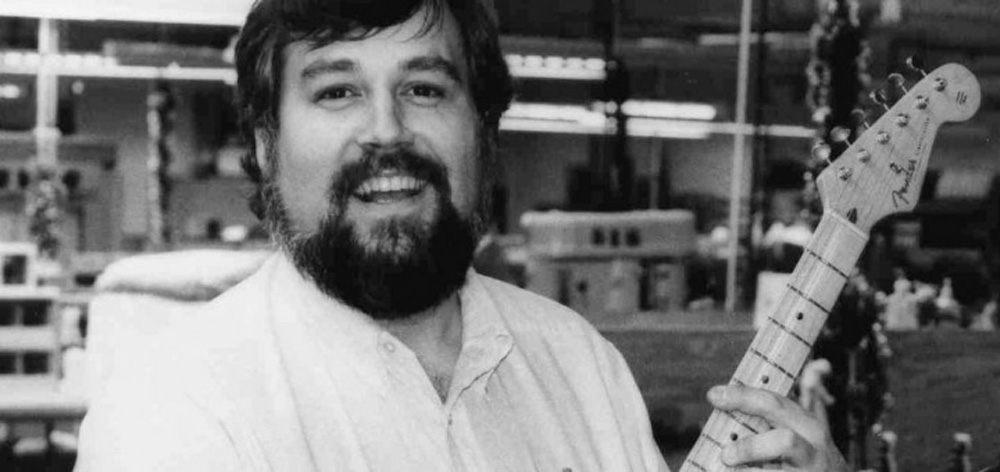
What did you actually buy from CBS?
We bought the names Fender, Rogers, and Rhodes, and Squier, and the product that was in stock, which we bought at a particular price. We bought the receivables, a lot of machinery. They had made an investment over the last four years before they sold it to try to get the factory back in shape.
In fact we’d done that, and as I say the heartbreaker about that was that after we’d broke our asses getting the factory doing the right thing, that’s when they pulled the plug, and the factory was not part of the deal. We were finally making really good guitars again with all this good equipment, and they pulled the plug. So we went through and selected the machinery we wanted, sold off the stuff we didn’t want. Also, part of the deal was that we got Fender Japan.
Fullerton was closed?
Yes, the plant closed in February ’85. We stayed there and used the front half of the facility. We had armed security guards and everything. You couldn’t go in and out of the front door. We used that until June, and then on a Friday in June we packed up, worked our asses off all weekend, and opened up the doors at Brea on Monday. We eventually established a new factory in Corona, which began production on a limited scale toward the end of ’85.
So Fender Japan was keeping you going in terms of product.
Oh yeah. In fact, they were our lifeline. We didn’t have any product from anywhere else. We were selling off what was left. All the time that we were upgrading our plant, they followed us. We started working on new equipment and designed new machinery they worked on. And Fujigen had probably one of the top two or three guitar factories in the world, and that’s basically [laughs] because of our involvement.
How did new Fender models of that period such as the Performer fit into the picture?
John Page designed the Performer, which was intended to be a U.S.A. model. John had this great design for a new bass, but the problem was that it was so far removed from the Jazz Bass that we couldn’t bring it out as a Jazz Bass. It was offset, but with its little horns and stuff it was just too far off. We were getting hammered from our sales force because Jackson was out there and some other people with these offset headstocks, these slanted, sharp headstocks. John’s original design had a Fender head.
Anyway, we said, "Hey, you gotta do a guitar to match," because it was such a cool body shape. He and I liked it, and we showed it to a lot of players and they liked it. So the reason that we went with the different headstock, that was my call, mainly because we were getting hammered from the outside: You’ve got to do something to compete with Jackson and all of that stuff!
The Performer’s head looked like the one on the Fender Swinger from the late ‘60s.
Yes, something that we didn’t have to worry about re-trademarking, because that’s always a hassle. But the sad thing about the Performer was, we introduced it at the trade show, it had a great response, we had all these players lined up to play the bass and the guitar—and right after the show was when CBS pulled the plug. I still think that was a great guitar, but it just got caught up in the midst of the sale.
The same thing happened with the Master series. At that point, Gibson was turning out shit, and they weren’t selling very well. So we figured if we could get something and get some good players playing it and not worry about selling big quantities, get our name around that we can make set-neck guitars like this, then we’re gonna do OK. The problem was, we introduced the line, we had pretty good response, but Fuji had manufacturing problems and we didn’t get any for over a year. So we introduced that to all this excitement, and nothing came out for a year. And then CBS pulled the plug.
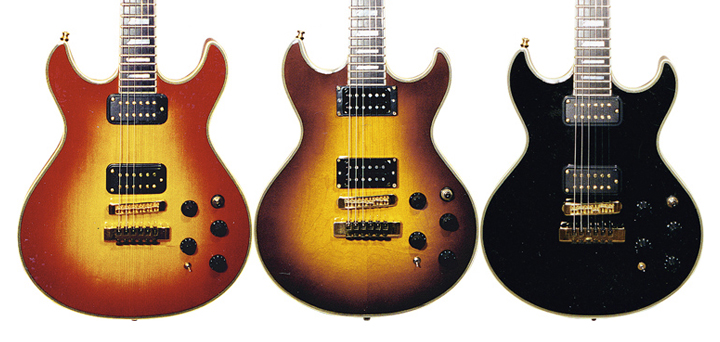
And none of these were Strat or Teles. How dare you!
Yes [laughs], Fender’s tradition. They were good guitars, they were made real well, they sounded good and everything else—but they weren’t Fender. Actually, we came up with lots of weird shapes through the years that never got near production. You’d take them out, ask what do you think? And again it would be like, This is not Fender. That attitude—it’s our biggest asset and it’s our biggest pain in the ass.
Tell me about the American Standard guitars. You introduced the Strat in ’86 and the Tele a couple of years later.
We started that project in the early ‘80s, like ’83 or so, with the Standard Strats and Teles that we brought out, with different bridges and things going on. But the concept was still there: We wanted to make a good quality, standard instrument that better addressed modern playing styles, and at a reasonable price. And they’ve done very well.
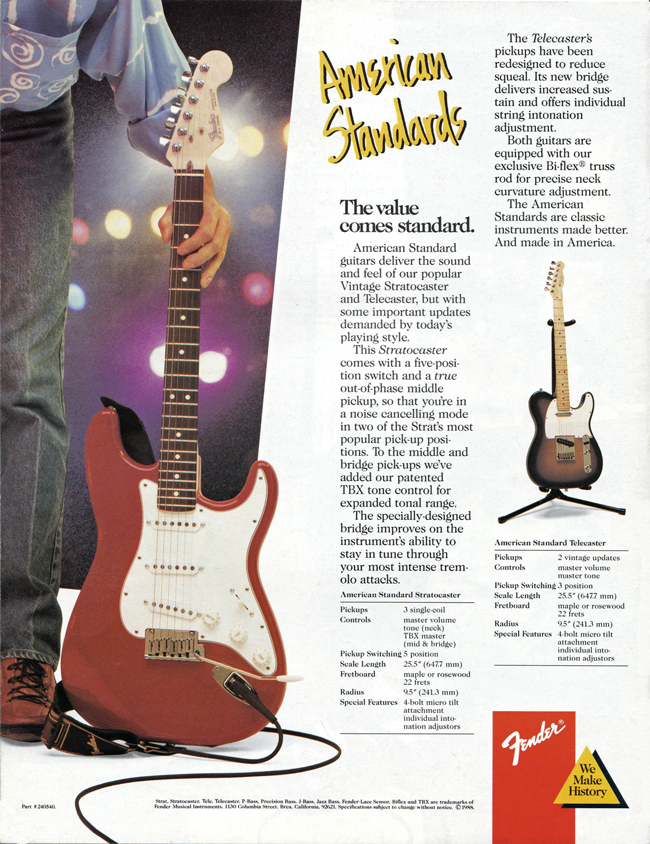
With the Tele, we decided we would redesign the bridge pickup. We had started that back in the early ‘80s. We were using a brass bridge plate, which has an effect on how the pickup performs, because the magnetic field is in the middle of that bridge plate—so the steel bridge plate has a particular kind of effect. On the vintage one, it has a copper-clad steel plate on the bottom of the pickup. But things aren’t perfect, and if that isn’t sealed up properly with wax, you can get a lot of squeal.
So we found that by eliminating the plate, and the fact we’d gone to the brass, that combination, along with the saddles, contributed to a fatter sounding bridge pickup. Still had a nice twank, or whatever you want to call it, a nice spikey, bitey sound, but it was fatter sounding and kind of sounded better through distortion.
What kind of Fenders will we be playing in the future?
Well, that’s very difficult. I just hope it’s not clarinets. I don’t think either of us would be surprised if we’re still playing vintage-style guitars ten years from now. I equally wouldn’t be surprised if there isn’t something else happening as well. It’s going to be interesting.
Maybe someone will pick up a Performer and be successful with that, and you’ll be making eight models of Performer reissues.
That wouldn’t bother me. That model had very unfortunate timing, came out just when the company was put up for sale.
But often that’s all it takes, for someone to just happen to pick up a guitar at the right time and make it famous.
That’s one thing that hasn’t changed. I think the product has to be right, but also someone in the public eye has to play it. It’s whatever catches people’s fancy. Generally, because there’s so much peer pressure involved in what we do, people have to be reassured into knowing that they didn’t make a mistake. It’s like when you buy a new car, when you’re younger, the first thing you have to do is to drive over to your best friend and take it out for a drive. You want to have somebody tell you that you made the right decision, and I think really that’s something that motivates us all. We are creatures of habit.
About the Author: Tony Bacon writes about musical instruments, musicians, and music. He is a co-founder of Backbeat UK and Jawbone Press. His books include The Stratocaster Guitar Book, The Telecaster Guitar Book, and Squier Electrics. His latest is a new edition of Electric Guitars: The Illustrated Encyclopedia (Chartwell). Tony lives in Bristol, England. More info at tonybacon.co.uk.
